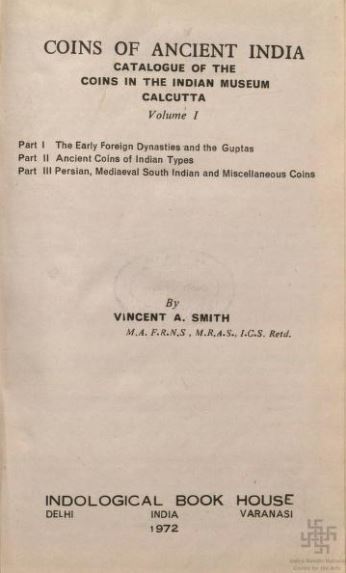‘Indian Coins History’ PDF Quick download link is given at the bottom of this article. You can see the PDF demo, size of the PDF, page numbers, and direct download Free PDF of ‘Coins Of Ancient India’ using the download button.
Coins of Ancient India Book PDF Free Download

BACTRIAN AND INDO-GREEK
THE coins of Sophytes, king of the Salt Range in the Panjab, the contemporary of Alexander (Pl. I, 1), form a class by themselves and are not connected with the subsequent development of coinage in India.
The Bactrian issues, on the contrary, are intimately associated with the local Indian coinage, and a few words of historical explanation are needed to show how the association arose.
In or about the year 250 n.c, Diodotos, governor of Bactria, revolted against the authority of the Seleukidan sovereign, and so needed in founding a new kingdom, the independence of which was formally recognized some forty years later by Antiochos the Great.
If Justin may be believed, the founder of the Bactrian money Barvived his success but a short time and was succeeded by his son of the same name.
The extant gold coins of Diodotos, one genuine specimen of which (Fl. L, 2) is in the Anistic Society’s cabinet, exhibit a rather youthful portrait, and it seems reasonable to accept Justin’s statement and distribute the coins to Diodotos II.
After some years, nay about 230 s.a., Euthydemos, a native of Magnesis, made himself master of Bactria. His coinage, which has high artistic merit, is well exemplified in PL I, 3, 4, 7, 8.
The barbarous imitations, supposed to have been struck at Charanene in Suniana (Pl. I, 5, 6, are excellent, illustrations of the way in which a fine numismatic type can be degraded by uneducated copyists.
Demetrios, son of Eathydemos, and son-in-law of Antiochos the Great brought the Bactrian power into contact with India by effecting considerable conquests in the borderlands of the latter country about 190 B.C. Specimens of his gains purely Hellenistic are shown in PL I. 9-11
The clammy rectangular coins of the closely related princes Aga takes and Pantaloon (Pl. II, 1, 2), which belong to the same period, obviously are semi-Indian in character and drive their peculiarity.
The exact dynastic position of Antimachos Theos, who issued some fine coins (Pl. II, 3, 4), cannot be defined. The scanty data available are sufficient to prove that Eukratides (about 175-156 B.c.) was one of the most notable of the Bactrian kings.
He defeated Demetrios, but was himself murdered by his own son, supposed to be Apollodotos, who became king of the whole or part of the Indian dominions; while Heliokles, apparently another son of Eukratides, ascended the throne of Bactria.
The portraits on the coins of Eukratides are particularly realistic and well-executed (PI. II, 5, 7). Heliokles was the last inde- pendent Greek sovereign of the short-lived Bactrian kingdom, and about 140 8.c. was overwhelmed by the irruption of swarms of nomads from Central Asia. Specimens of his coinage, distinctly inferior in merit to that of Eukratides, are shown in Plate III.
The coinage of Apollodotos (Pl. IV) is very abundant in some types. The square varieties are much more Indian than Greek.
Although the Bactrian monarchy to the north of the Hindi Kush was overthrown by the nomad hordes, Greek princes continued to rule the country which we now call Afghanistan, as well as the Panjab and Indus valley, for some time longer.
The most famous of these Indo-Greek princes was Menander (Milinda or Milindra of Indian literary tradition?), who reigned from about 160 to 140 B.c., and effected an invasion of India, during the course of which he traversed Rajputana and Oudh. His well-executed coinage (Pl. V) was issued in large quantities, and some varieties are quite common.
Numerous other Greek princes ruled locally at various points on the Indian frontier, and specimens of their coinage will be found represented in Plates III-VI.
The last of them was Hermaios, king of Kabul, who was subjugated by Kadphises I (Kujulakara, &e.), chief of the Kushan section of the Yueh-chi horde, about 45 a.p.
For a time the Greek king and the barbarian chieftain shared the sovereignty of Kabul, but gradually the Greek power was wholly obliterated, and the Kushan attained undisputed dominion. The political changes are reflected in the coins (Pl. VI, 11-15, and PL XI).
| Author | Vincent A Smith |
| Language | English |
| No of Page | 395 |
| PDF Size | 183.5 MB |
| Category | History |
Related PDFs
History MCQ Book PDF For Competitive Exams Free
Advanced Study In The History Of Medieval India PDF
Letters From A Father To His Daughter: Jawaharlal Nehru PDF
India After Gandhi By Ramachandra Guha Book PDF
The Wonderful Wizard Of Oz PDF By L. Frank Baum
Coins of Ancient India Book PDF Free Download

My coin is sel me sir